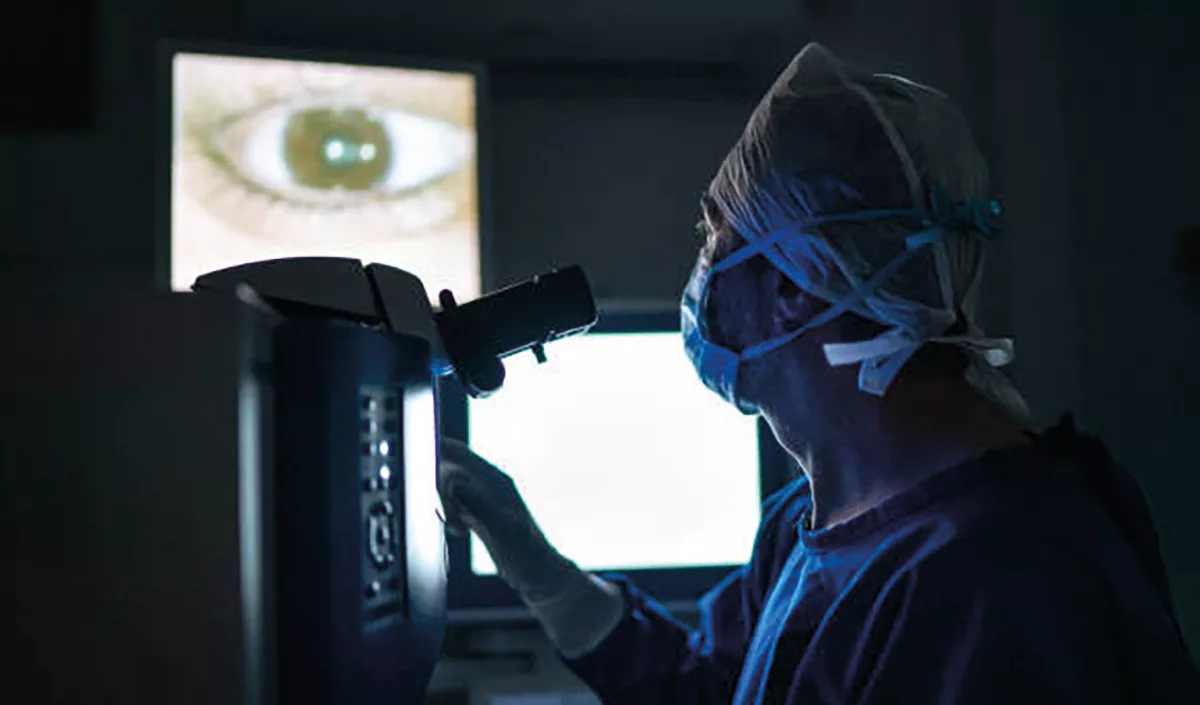
Nine Insights On The Future Of Cataract Surgery
SpaMedica’s medical director, Dr. Alex Silvester, discussed the future of cataract care at 100% Optical 2023. This article has been covered by an AOP website
SpaMedica’s medical director, Dr. Alex Silvester, opened his 100% Optical session by identifying cataracts as the number one cause of blindness for the over the 50s
SpaMedica’s medical director, Dr Alex Silvester, opened his 100% Optical session by identifying cataracts as the number one cause of blindness for the over the 50s.
The top five causes of blindness, identified by delegates at SpaMedica’s 100% Optical session
- AMD
- Glaucoma
- Cataracts
- Diabetes
- Uncorrected refractive error.
The discussion workshop, entitled The future of cataract surgery – innovations, technology and medication, took place in the Future Practice Consulting Room on Saturday 25 February.
Silvester began by giving a potted history of how the first intra-ocular lens came about (in 1948, as a result of the Second World War) and then presented delegates with a question: what is next?
Ideas discussed included the potential of delivery robots for surgery, which delegates discussed in terms of improved patient outcomes, sustainability, and efficiency.
Silvester then shared insight into a trial that is due to take place at SpaMedica, using operative medication that will seek to improve patient experience by controlling pain during surgery, maintaining pupil dilation, and reducing post-operative inflammation.
The potential innovation in technology that may have come about as a side effect of COVID-19 was also discussed, with video consultations, drive-through glaucoma checks, improved care in the community both pre- and post-cataract surgery, and SpaMedica’s finger prick testing for Warfarin all identified as examples of recent progress.
Nine insights on the future of cataract surgery that were discussed in the workshop:
The “jury is still out” on bilateral surgery for cataracts
Silvester acknowledged that bilateral eye surgery has taken place in recent years due to time pressures as a result of the pandemic. He also told delegates that he has previously performed bilateral surgery on children, due to the risk of general anaesthetic. However, he emphasised that there are still risks and concerns with this approach, including bilateral refractive surprise, bilateral corneal oedema, bilateral uveitis, and bilateral cystoid macular oedema.
Potential of the Malyugin Ring
Silvester spoke about the potential of the Malyugin (M) Ring, which he described as being similar to a paper clip with a hook. The M Ring can be inserted into the eye during surgery to temporarily stretch the pupil, making it easier to operate. He acknowledged that that device is expensive, but that it “works really well” and “as an innovation, is fantastic.”

Innovation in lenses
Silvester went on to speak about innovation in the lens space, acknowledging that outcomes with multifocal and enhanced monovision lenses are “fantastic” – and that they are often a cost-effective solution.
He added a note of caution, however, reminding attendees that there is currently no scientific evidence to support the claim that yellow lenses can reduce severity of acute macular degeneration.
Can we innovate with eye drops?
“There is no standard guidance on the use of eye drops post-cataract surgery,” Silvester said, and little consensus on how they should be used, or for how long. When considering this, he emphasised that the risks of antibiotic resistance should be considered, sharing the results of a risk stratification study of 38,000 people that suggested that drops may only be needed for one week.
Eye surgery without drops
Trial with peri-operative non-steroidal anti-inflammatory drugs (NSAIDs) could be a ‘game-changer,’ Silvester said, controlling inflammation as it occurs rather than post-operatively.
The potential for robotic eye surgery
The potential benefits of robotic eye surgery – efficiency, accuracy, sustainability – were highlighted early in the session. Silvester returned to the topic later, sharing that technology that can allow this innovation to happen has already been developed in Israel and that he believed it will be seen more widely within the next five-10 years.
Artificial intelligence (AI) for lens predictions in the future?
Silvester emphasised the potential of AI in making lens predictions in the future, telling delegates that the technology is now able to predict a patient’s age, sex, whether they are a smoker, and which eye is being looked at, with 99% accuracy.
These are things that a human would not be able to identify just from looking at the eye, he said. Attendees were able to visit SpaMedica’s stand after the session to see if they could ‘beat the AI’ themselves.
Silvester is also working with the University of Manchester on a project to analyse post-operative data to see if refractive outcomes can be further improved, he said.
Improved training for eye surgery
Silvester noted that, in various SpaMedica locations, trainees are now able to observe and learn how to perform cataract surgery from experienced surgeons. “Training future ophthalmologists is the future of cataract surgery,” he said.
Compound 29: the future of cataract surgery?
Compound 29, a drop that is currently being developed, could have the potential to dissolve cataracts in the eye, negating the need for surgery completely.The benefits to this could be huge: in 2020, a study published in Modern Optometry said that the drop could be “a game-changer as a less expensive, non-invasive option for treating a leading cause of blindness.”







